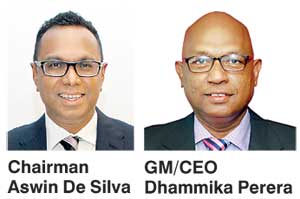Thursday Nov 14, 2024
Thursday Nov 14, 2024
Friday, 31 March 2017 04:31 - - {{hitsCtrl.values.hits}}
NSB’s operating profit at Rs. 16.1 billion recorded a 4% increase as compared to the previous year.
These reported profits were achieved despite lower interest margins on account of an elevated market interest rate scenario.
The growth in its traditional lines of business enhanced fee-based income and saw an improvement in the credit quality of its asset portfolio, resulting in lower provisioning being the main contributory factors leading to this growth in profitability.
Interest income of the bank grew by 11% to reach Rs. 86.4 billion whilst the net interest margin reduced to 2.9% in 2016 from 3.3% in 2015. The bank has augmented these market challenges with growth in volumes to post an increased profit.
The total assets of the bank surpassed Rs. 900 billion and are currently at Rs. 911.7 billion, while the deposit base grew by 10% to  reach Rs. 657 billion by 2016. The bank’s loans and advances portfolio grew by 19% primarily assisted by advances within the retail sector.
reach Rs. 657 billion by 2016. The bank’s loans and advances portfolio grew by 19% primarily assisted by advances within the retail sector.
Its Non-Performing Loan ratio at 1.55% testifies to the prudent management of its asset portfolio with emphasis on strengthening its balance sheet.
A contribution of Rs. 19.2 billion to the Government in the form of dividends, levies and taxes is the highest in its history, thus signifying its critical role within the state sector.
The bank continued to play a dominant role in the housing loan market and lending to needy sectors by way of granting loans at concessionary interest rates. The bank’s contribution to CSR programs through the acclaimed Hapan scholarship program and Sooryabala Sangramaya loan scheme introduced to purchase solar panels was noteworthy.
In another unique initiative, the bank raised Rs. 6 billion from the local market through a private placement of debentures to strengthen Tier II capital. The bank’s Tier 1 capital adequacy ratio stood at 12.5% while total capital adequacy was 14.7% at the end of 2016.
The bank has also been at the forefront on some of the European markets in attracting inward remittances and also strengthening partnerships in international markets.
The bank expanded its network by increasing its number of branches to 250 while its ATM network was increased to 279 by the end of 2016 which is connected to Lanka Pay locally and MasterCard and Visa internationally.
The bank has recently rolled out a three-year strategic business plan with clearly identified imperatives for a period of sustained growth.